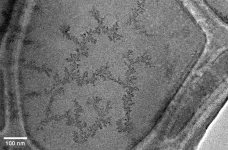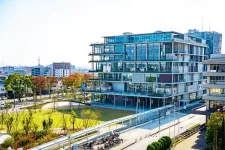(Press-News.org) LOS ANGELES — Researchers at City of Hope®, one of the largest and most advanced cancer research and treatment organizations in the U.S. with its National Medical Center named top 5 in the nation for cancer by U.S. News & World Report, have found that cell mutations are necessary but not always sufficient for tumors to form. Instead, they suggest that additional risk factors that promote tumor growth, like chronic inflammation, are a key trigger for tumor formation.
The study findings, published this month in Cancer Discovery, answer a question that scientists have long asked: Are cell mutations alone — whether genetically inherited or acquired through lifestyle choices — enough to cause cancer?
“As a society, we have mostly focused on preventing mutations, like persuading people to stop smoking and to avoid water or food pollutants like plastics or heavy metals,” says Yun Rose Li, M.D., Ph.D., lead author of the paper and an assistant professor in City of Hope’s Department of Radiation Oncology and Department of Cancer Genetics and Epigenetics.
“Yet our study suggests an urgent need for cancer prevention strategies that target the biological mechanisms that trigger malignant tumors to develop and not merely focus on exposure to pollutants that cause mutations.”
For example, Dr. Li says, not all smokers get lung cancer. She explains that while smoking likely acts as the initial carcinogenic event that causes cell mutations, those cells may then need a secondary inflammatory process to drive tumor formation. Knowledge about what pushes tumors to develop could be used for comprehensive personalized risk assessment tests like those provided by City of Hope’s Cancer Screening & Prevention ProgramSM.
“We all have cells that will inevitably mutate, whether due to environmental mutations or random errors during cell division and tissue repair. From a public health standpoint, what people need to understand is that yes, it is important to avoid hazards, like smoking, that cause mutations, but it could be even more important to avoid situations that cause chronic inflammation — such as eating a high-fat diet or obesity — because inflammation is the match that ignites cancer,” says Dr. Li, who holds a joint appointment in The Bioinnovation and Genome Sciences Division at Translational Genomics Research Institute, part of City of Hope.
Other causes of chronic inflammation include excessive alcohol, lack of exercise, chronic stress, autoimmune disorders like rheumatoid arthritis or inflammatory bowel disease, and an imbalance of healthy and unhealthy microbes in your gut.
The researchers applied modern sequencing technologies to study inflammation-driven tumor models by replicating an experiment from the 1950s. First, they applied two drugs, one to cause mutations followed by a second to create local inflammation, on skin tissue. As expected, they found that tumors will form when the animal model’s skin was exposed to the first drug that causes thousands of cell mutations followed by the second agent. The assumption based on their observations is that the immune system does not fix or clear out mutated cells, nor do these mutated normal cells naturally “die out.”
They applied whole genome sequencing to confirm that the primary mutations were caused by the addition of the first inflammation-causing carcinogen, which is essential to cancer development. But neither agent on its own caused tumor formation. They went one step further to show that even a single exposure as a fetus to a low dose of the first drug is sufficient to trigger the same mutation types that can be sufficient for tumor formation when the embryos become adults and are exposed to the inflammatory signal.
“What this means is that the initial exposure is sufficient in and of itself to cause all the necessary mutations that are required for tumor formation, but tumor development is reliant on the availability of this second signal or tumor promoter,” says Dr. Li, noting that while the work was done in skin cancer models, the findings can likely be applied broadly to many cancers, especially those that are age- and lifestyle-related. “Mutated cells are still a lifetime risk factor. They're ticking time bombs lying latent, ready to be awakened.”
The researchers will now investigate the exact cellular mechanisms of tumor promotion. For example, Dr. Li wants to explore how metabolic dysfunction can modify the epigenome, creating conditions that awaken latent mutated cells.
“By learning more about how tumor promotion works, my hope is that this work can have major implications for the development of new strategies for cancer prevention,” Dr. Li says.
# # #
The Cancer Discovery study entitled “Long term latency of highly mutated cells in normal mouse skin is reversed by exposure to tumor promoters and chronic tissue damage” was supported by funding from Cancer Research UK, the National Cancer Institute, the National Institutes of Health and the Scientific Foundation of the Spanish Cancer Association.
About City of Hope
City of Hope's mission is to make hope a reality for all touched by cancer and diabetes. Founded in 1913, City of Hope has grown into one of the largest and most advanced cancer research and treatment organizations in the U.S., and one of the leading research centers for diabetes and other life-threatening illnesses. City of Hope research has been the basis for numerous breakthrough cancer medicines, as well as human synthetic insulin and monoclonal antibodies. With an independent, National Cancer Institute-designated comprehensive cancer center that is ranked top 5 in the nation for cancer care by U.S. News & World Report at its core, City of Hope’s uniquely integrated model spans cancer care, research and development, academics and training, and a broad philanthropy program that powers its work. City of Hope’s growing national system includes its Los Angeles campus, a network of clinical care locations across Southern California, a new cancer center in Orange County, California, and cancer treatment centers and outpatient facilities in the Atlanta, Chicago and Phoenix areas. City of Hope’s affiliated group of organizations includes Translational Genomics Research Institute and AccessHopeTM. For more information about City of Hope, follow us on Facebook, X, YouTube, Instagram and LinkedIn.
END
March 26, 2025
We Are Vastly Overestimating the Amount of Fresh Water Available for Lithium Mining, New Study Finds
New research led by UMass Amherst hydrologists sounds the alarm over mining practices that have immediate implications for transition to low-carbon economy
AMHERST, Mass. — New research into lithium mining in the “Lithium Triangle” of Chile, Argentina and Bolivia — source of more than half of the world’s lithium resources — shows that the commonly accepted models used ...
March 26, 2025
AMHERST, Mass. – Many native plants in the U.S. cannot possibly move themselves fast enough to avoid climate-change driven extinction. If these native plants are going to have any chance of surviving into the future, they’ll need human help to move into adjacent areas, a process known as “managed relocation.” And yet, there’s no guarantee that a plant will thrive in a new area. Furthermore, movement of introduced plants, albeit over much larger distances, is exactly how the problem of invasive species began—think of kudzu-choked forests, wetlands taken over by purple ...
SAN DIEGO, March 26, 2025 — On the shelves of makeup counters and drugstores sits an array of foundations in various olive, ivory and fair shades. But for people with darker skin tones, finding the right foundation shade can be a challenge. Dark foundations on the market often fall flat, appearing gray-like once applied on the skin. But now, researchers report a blue cosmetic color additive that gives these foundations the warmth and depth they currently lack.
Gabriella Baki, associate professor of pharmaceutics and director of the cosmetic science and formulation design undergraduate program at the University of ...
SAN DIEGO, March 26, 2025 — Sometimes cell phones die sooner than expected or electric vehicles don’t have enough charge to reach their destination. The rechargeable lithium-ion (Li-ion) batteries in these and other devices typically last hours or days between charging. However, with repeated use, batteries degrade and need to be recharged more frequently. Now, researchers are considering radiocarbon as a source for safe, small and affordable nuclear batteries that could last decades or longer without charging.
Su-Il In, a professor at Daegu Gyeongbuk Institute of Science & Technology, will present his results at the spring meeting of the American Chemical ...
SAN DIEGO, March 26, 2025 — Can you imagine a smartphone with a wooden touchscreen? Or a house with wooden windows? Probably not — unless you’ve heard of transparent wood. Made by modifying wood’s natural structure, this material has been proposed as a sturdy, eco-friendly plastic alternative. But wood’s biodegradability is often sacrificed in the process. Researchers are hoping to change that by creating transparent woods from almost entirely natural materials and making them electrically conductive.
The researchers will present their results at the spring ...
Statement Highlights:
By age 18, many adolescents have already developed heart disease risk factors, such as high blood pressure, obesity, high cholesterol or Type 2 diabetes, and a growing number of younger adults are experiencing adverse cardiovascular events.
Numerous social determinants of health and developmental and life changes impact cardiovascular risk as young people progress from their teens to their mid-20s.
The statement describes the challenges and opportunities for easing the transition ...
Those who start work earlier express more discomfort with the seasonal time change. This is the main conclusion of a study that the lecturers at the University of Santiago de Compostela (USC) and the University of Seville (US), Jorge Mira Pérez and José María Martín Olalla, have just published in the journal Chronobiology International, in which they analyse in detail the results of the public consultation organised by the European Commission in 2018 in the then 28 member states, which ...
Scientists have for the first time filmed the real-time growth and contraction of Palladium nanoparticles, opening new avenues for utilising and recycling precious metal catalysts.
Researchers at the University of Nottingham’s School of Chemistry used transmission electron microscopy (TEM) to observe the complete lifecycle of palladium nanoparticles in a liquid environment, from nucleation through growth to dissolution, with the entire cycle repeating multiple times. This study has been published today in Nanoscale.
One of the most important applications of metal nanoparticles is in catalysis, which forms a backbone of chemical industries. Dr Jesum Alves ...
The world’s amphibians are in trouble. Because of their sensitivity to climate change, habitat loss, and pollution, they may be the canary in the coalmine for the nascent anthropogenic mass extinction. Approximately 200 amphibian species have become extinct since the 1970s, and the International Union for the Conservation of Nature estimates that 34% of the 7,296 known remaining species are likewise at risk.
Another reason why amphibians are vulnerable is their susceptibility to disease. An emerging, potentially deadly disease of frogs and salamanders is ranavirus, a genus of at least seven species within the family Iridoviridae. Ranavirus can rapidly jump ...
Designing walkable neighborhoods has gained attention as a method to increase physical activity among urban populations. Moreover, highly walkable areas stimulate increased neighborhood retail sales, higher property values, and greater urban sustainability. However, only limited methods are available for improving walkability in the urban centers of highly motorized suburban cities. In the urban areas of suburban cities, increasing land-use diversity by opening a multifunctional facility is considered one of the most effective strategies for an architecture-scale intervention.
Dr. Haruka Kato, ...









